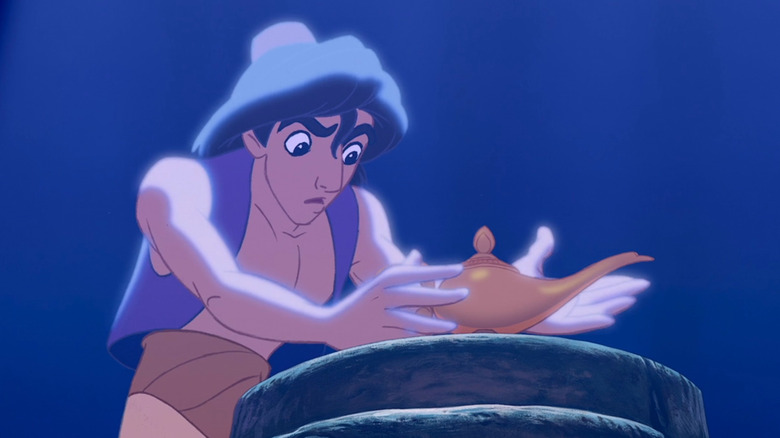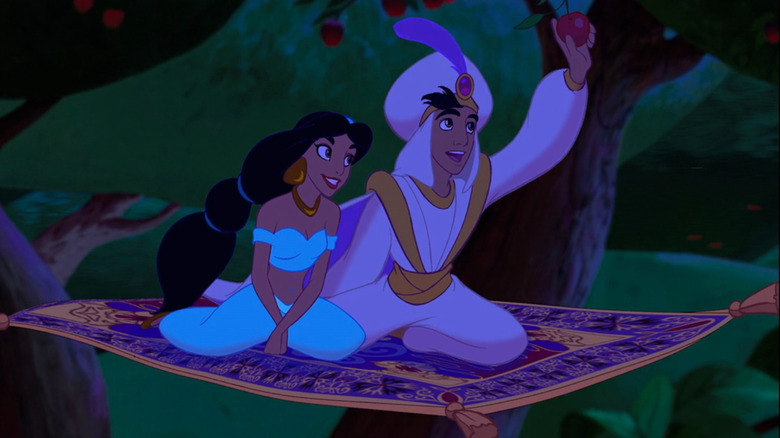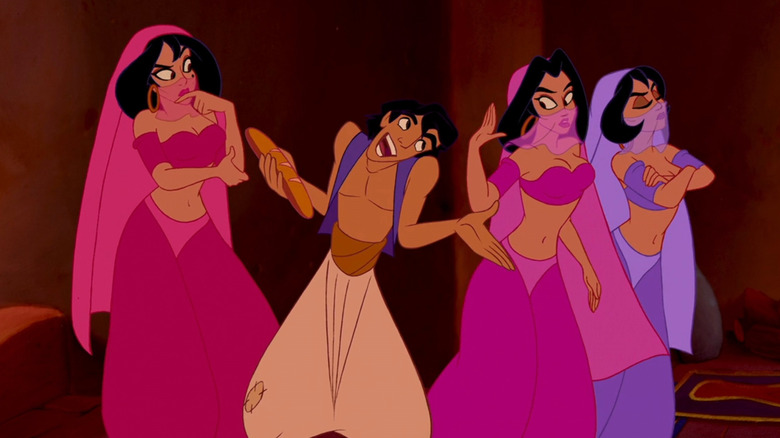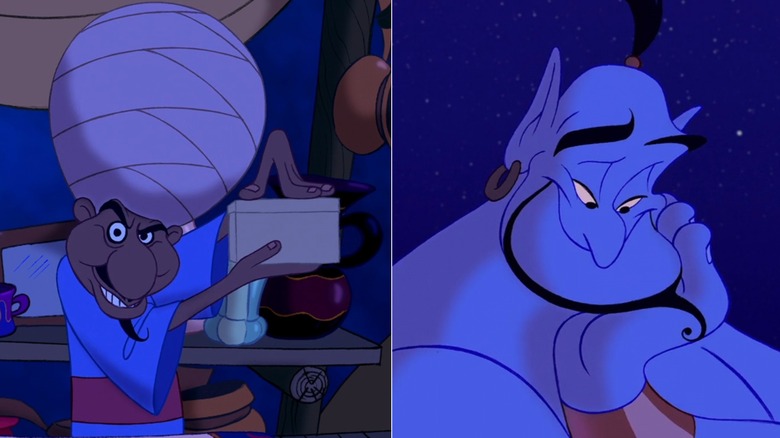Disney Fan Theory: Aladdin Is Actually A Dark Postapocalypse Story In The Future
"Aladdin" may be a comforting childhood classic for many, but potentially hidden beneath its collection of colorful characters and lively songs is a far more distressing reality. One intricate fan theory paints a dark picture of the world of the film and why it is the way it is.
Even though "Aladdin" is said to be set in the ancient fictional Middle Eastern city of Agrabah, some viewers have theorized that the animated film actually takes place in a distant future. What evidence points to this being the case? Look no further than the lovable Genie (voiced by Robin Williams). When initially summoned from the lamp, Genie comments that he's been imprisoned for 10,000 years. Later, while giving Aladdin his makeover, Genie states, "That fez and vest combo is too much third century." If we take this as the last time that Genie was out and about, then the earliest that "Aladdin" could take place is 10,300 A.D.
But some believe that "Aladdin" is set in an even later time. Genie is not only wise when it comes to granting wishes but also seems well-versed in his entertainment knowledge, with a knack for impersonating contemporary figures like Jack Nicholson, Arnold Schwarzenegger, Ed Sullivan, and even Disney's own Pinocchio. As his pop culture know-how only seems to extend to the film's 1992 release date, the theory holds that this is the year the movie's modern world ended, which would mean that the film is set in 11,992.
Aladdin isn't so magical when you take this theory into account
O.K., so Genie makes a few modern references and cracks jokes about Aladdin's clothes, but how does that indicate that the Disney film takes place in the future, let alone a desolate one? For this, fans have looked beyond the movie and examined the official "Aladdin" video game.
Many of the game's backgrounds are comprised of decimated structures, human skeletons, and atomic bomb shells, indicating that Agrabah was at the center of a great war that set it back to Bronze Age technology.
This also explains many of the seemingly magical elements present in the film. Aladdin's trusty Magic Carpet, for example, is theorized to be powered by some sort of flight technology that has been hidden away in the Cave of Wonders, a place where abandoned technology of yesteryear has been left to the sands of time. This may also explain why it can travel around the world so quickly. However, some theorize that Genie, discovering that much of the world didn't survive the mysterious disaster, crafted a simulated reality for Aladdin and Jasmine to fly through.
Another fantastical element this theory explores involves the animals inhabiting Aladdin's world. It's postulated that Iago (voiced by Gilbert Gottfried), who obviously speaks because he's a parrot, may also have been affected by radiation, granting him an extensive vocabulary. Similarly, Abu's immense intelligence and ability to outwit humans may also be chalked up to enhancements brought on by similar means.
The culture of Aladdin's world also points to an evolved society
Even if "Aladdin" takes place in a world decimated by war and destruction, there are other aspects of this theory that illustrate how far humanity has progressed since the movie's apparent 15th-century setting. In particular, some fans have taken note of how the film handles religion and cultural norms.
Taking place in the Middle Eastern region, it can be assumed that most Agrabah residents follow the Islamic religion. While Allah, the Muslim term for God, is used a few times throughout the film, alongside certain clothing and architectural indicators, Agrabah's citizens don't hold on to the traditions of Muslim people. This is most evident in the way many of the film's female characters dress, with both their stomachs and hair showing. In traditional Muslim culture, women are not allowed to reveal such features in public.
Princess Jasmine takes things a step further. Not only does she dress how she pleases, but she is not above speaking her mind. She criticizes her father, Jafar, and Aladdin for determining who she should marry, wanting to be with someone of her own accord instead of being handed off like a trophy. Such a forward-thinking attitude would not fly in conventional Muslim society, especially in ancient times. But in a future where such ideas may have been abandoned, it doesn't sound so absurd.
Another famous Aladdin theory has been confirmed by its directors
So is there any merit to the idea that "Aladdin" is a postapocalyptic tale? Unfortunately for Disney theory aficionados, the film's creators have largely laughed this idea off. In a 2015 interview with E! News, "Aladdin" co-director John Musker was confused upon learning about it. "Far into the future? I haven't even heard that one," he reacted. That said, the filmmakers did confirm the accuracy of another longstanding "Aladdin" rumor.
Many viewers have speculated that the peddler from the movie's beginning is Genie in disguise, regaling the story of "Aladdin." The character possessing the lamp, having a witty sense of humor, and being voiced by Robin Williams combine to give this theory a lot of weight. As with all things in animation, these details were not included by mistake.
When speaking about the theory to E! News, co-director Ron Clements pointed out that these dots were indeed designed to connect. "That was the whole intention, originally," he shared. "We even had that at the end of the movie, where he would reveal himself to be the Genie, and of course Robin did the voice of the peddler. Just through story changes and some editing, we lost the reveal at the end. So, that's an urban legend that actually is true."
While it may be disappointing that the idea of a postapocalyptic Agrabah was not on the minds of the "Aladdin" team during the film's making, that doesn't make the theory any less fascinating for fans. In the end, whether you choose to view the film in this light or not, it doesn't make "Aladdin" any less of a beloved classic.



